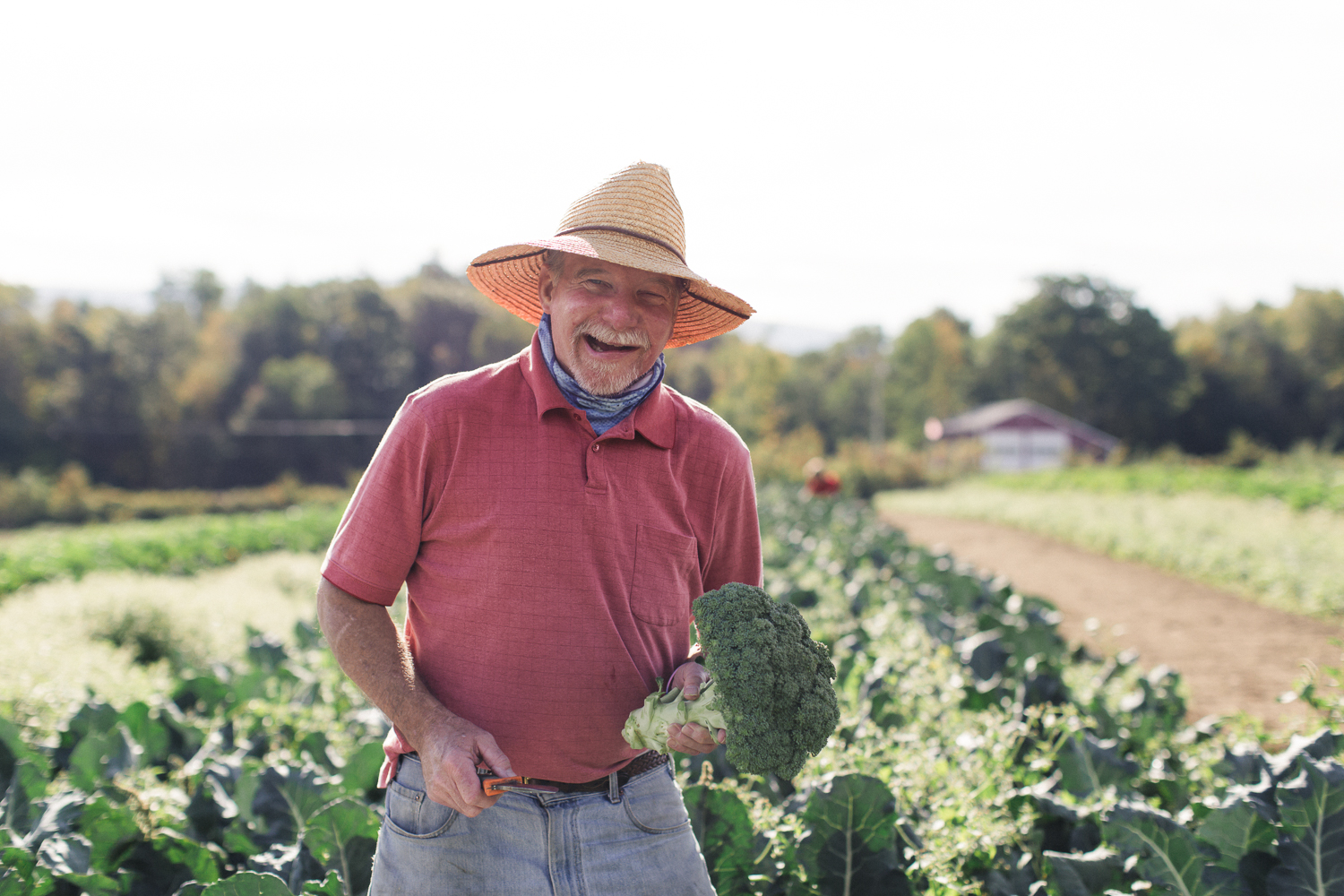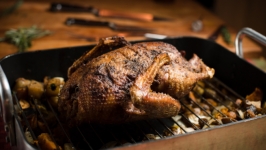Grateful Hearts—Rescuing Food, Feeding Neighbors, Building Community
With 40% food waste, no one should go hungry. Produce can rot in a farmer’s field, and it can also go unused in community food pantries. That stark reality motivated Dale Coppin to take action.
Dale is a networker, problem solver and logistician who spent his career as a quality assurance manager for a Fortune 500 company. “When I see things that need to be corrected, I don’t sit still.” He met with the team who runs the Manchester Community Food Cupboard in 2010 and brainstormed a solution: soups, stews and casseroles made by a professional chef from unused or gleaned produce. These frozen meal packages could be distributed at food pantries and other outreach agencies.
At the same time, Dale was director of community service at his church. “I sent an email saying we had 40 kids and thousands of pounds of food going to waste, and we wanted to find someone who could help us prepare these meals professionally. A woman responded and said this is just what her husband had been looking for, but he was out west skiing. She volunteered him anyways.”
That skier turned out to be Jeff Scott, executive chef at the West Mountain Inn in Arlington. “Jeff jumped on board and we became very close friends, bonding at first over our common admiration of the Grateful Dead. Naturally we named the project Grateful Hearts. Jeff, God bless him, would come to St. Paul’s kitchen on his day off every week and prepare the meals from our gleaned product. Some days, he would drag himself in, exhausted, after having catered a big weekend wedding at the inn. But he said that when he left at the end of the session, he felt revived because of what he had just accomplished. Jeff did this for five years. The Hearts wouldn’t have gotten off the ground without him.”
Next came the connection with Southwestern Vermont Medical Center in Bennington. In July 2016, Dale knocked on the door of Tiffany Tobin, director of hospitality services, knowing he had about 30 seconds to make his elevator pitch. As Tiffany recounts, “That turned into a two-hour meeting and this incredible partnership. I ran down the hall and got Laura LaCroix, our executive chef, and said you gotta hear this guy. This is exactly what we’re looking for.”
This is exactly what we’re looking for. Talk to anyone involved with the Grateful Hearts, and you’ll hear that phrase pop up again and again. From the farmers and gleaners who provide the product; the chefs who orchestrate the cooking; the “chop and chat” and packaging crews; and the volunteers who distribute these frozen packets to outreach agencies in the Manchester and Bennington area: Everyone touched by the Hearts, as Dale calls his ever-expanding team, is infused with vigor, purpose and joy. This program nourishes those who prepare and provide the meals as well as those who receive them.
Leaders embody the philosophy and energy of their program. Dale Coppin radiates enthusiasm and gratitude for life, and his can-do spirit is contagious. This man who battles cancer signs every email, “It’s a great day to be alive.”
Thanks to the partnerships he has developed, Grateful Hearts runs on less than $1,000 annually. “We pay $500 for insurance even though we’re protected under the Good Samaritan law. The rest goes to FDA-approved freezer bags, a heat sealer and labels. It’s staggering how many people benefit from such a small capital expenditure.”
That investment results in more than 30,000 individual meals each year, made with perfectly good food that was destined for the garbage. “I’m on the Hunger Council,” Dale says, “and people around the state are worrying about Act 148 [the Universal Recycling and Composting law]. Well, we have an answer right here,” he continues. “We’re proving that you can take that food and put it to good use to feed your neighbors. The key is finding a facility and a cook. If a community has a hospital and a support staff, you can start right there. If not, you can hopefully find a chef and connect with a commercial kitchen—a VFW, senior center, church or school. Volunteers will come out of the woodwork because they see the direct impact that two hours of time can have. The concept sells itself and I’m just privileged to be a witness.”
Partnering with Southwestern Vermont Medical Center allows for commercial scale production and expansion into Bennington. Laura LaCroix, executive chef, explains: “We simplify and streamline the process. If we’re dicing celery, chopping onions, or peeling potatoes for the hospital, we run another 100 pounds for the Hearts. Prep happens through the week, fitting it in where we can. We also have storage and refrigeration space. For example, when Clear Brook Farm gave us 22 bins of fresh broccoli, our staff knew how to handle it. However, we’re still recovering from the 1,000 pounds of butternut squash that showed up last fall….”
Tiffany Tobin adds, “From an employer standpoint, involving your teams in a program like this can really improve your company’s culture. It offers a rewarding change of pace that allows the team to stretch their culinary skills and give back to those in need. Our employees have expressed such satisfaction since working with this program. We’ve had representatives from other hospitals come tour the kitchen and meet with Laura to see how this program unfolds logistically. Explaining the success we’ve had down here is starting to spark interest up north.”
Meanwhile, back in Manchester, the chop and chat volunteers gather with Kate Ebbott each Monday at St. Paul’s church kitchen. Kate had developed a program in Connecticut that produced 150 meals a week for undernourished kids. “This is in her DNA,” says Dale of his new chef. “Kate is a gem, just like Jeff. It takes a special person who has the dedication to oversee this every week without pay. And now with all the gleaned product we’re sourcing each week, Kate has the food safety knowledge and culinary talent to handle this influx of food.”
Savory bread pudding with Swiss chard, sausage and cheddar. Spiralized zucchini with kale pesto and quinoa. Beet, fennel and ginger soup. Roasted carrot, potato and lentils with miso parsley dressing. Braised greens and root veggies in white wine. These are just a smattering of the creative—and nutritious—meals that Kate generates each week. With food that would otherwise go to waste.
Her approach to cooking is ”clean, colorful and close.” is how Kate describes her cooking. “Heidi Lynn, who coordinates gleaning from the Dorset Farmers Market and Price Chopper, gives me a heads up on Sunday afternoon of what she has picked up so I can start to think about recipes,” Kate says. “I love the creative challenge of working with unexpected ingredients, but I need to have a framework in mind so we can hit the ground running on Monday morning.” Supplements like eggs, yogurt, cheese, dry beans and pasta come from the Community Food Cupboard.
Kate tests recipes during the week to ensure they freeze well and taste good. In the midst of chop and chat, she also makes a vat of vegetable stock so that nothing goes to waste. Over the course of a typical eight-hour Monday, two shifts of volunteers help Kate prepare 300 to 500 meals. And then another crew arrives on Tuesday to help Dale package the meals into individual portions in heat-sealed bags.
“This blends my passion for nutrition and sustainability with feeding our neighbors,” Kate says. And yes, this was exactly what she had been looking for.
The third component of Grateful Hearts involves a handful of teenage boys. “The boys in the Twilight program of Mount Anthony Union High School in Bennington work with me from 8 am to noon,” Dale explains, “provided their academics are up to snuff. They take their classes from 2:45 to 5:45. The key is not just graduation but to help them develop confidence, hopefully discover a passion that might lead to a career and prove that they can be contributing members of society. Each week, we glean from nearby farms. Lisa MacDougall of Mighty Food Farm and Andrew Knafel of Clear Brook Farm offer crates and crates of produce or open their fields to our gleaning boys. Moses Farm in Eagle Bridge had hundreds of pounds of surplus potatoes that they wanted to donate. So we picked them up each week and felt like Easter bunnies delivering them to food pantries and soup kitchens—everybody takes potatoes! The Twilight boys also help me package and distribute the SVMC meals around Bennington.”
Amazing things can happen with small, dedicated teams.
“This program seems to attract doers like Kate, Heidi, Laura, Tiffany, Patty Sargent who handles our computer tech, chef Sandy Kraehling who pinch-hits for Kate, and so many other wonderful people, including high school kids seeking guidance. They’re concerned about the health of their community and want to find ways to help alleviate the problems. This is a working template with incredible potential that can be followed by every community in the state. With hospitals on our side and talented chefs like Kate in smaller communities, the sky’s the limit. My prayers have been answered, and this has been a dream come true. The Big Guy upstairs has given me more time which proves I’ve still got work to do here.”
Maria Reade enjoys the privilege of volunteering with the Grateful Hearts. And yes, this is exactly what she was looking for…










